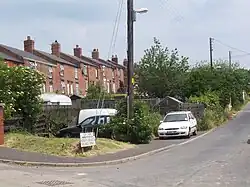Woolley Colliery
Woolley Colliery was a coal mine near Darton in the West Riding of Yorkshire. Coal mines were worked as early as 1850, and at about that time two rows of terrace cottages were built to accommodate miners. The pit village, Woolley Colliery is now in the Darton East ward of Barnsley Borough Council in South Yorkshire.[1] The colliery site is now occupied by a residential housing Development Woolley Grange which is in the City of Wakefield in West Yorkshire.
Colliery
Several coal seams outcrop on the hillside and coal had probably been mined in the area for many years, but only on a small scale until railway transport began.[2] The colliery began when two tunnels or drifts were dug into the Barnsley bed seam in the hillside. Vertical shafts were sunk to reach the deeper seams. Woolley Colliery was established in 1869. It had three shafts, three seams (named Fenton, Lidgett and Thorncliffe), and five coal faces. Woolley Colliery was nationalised in 1947 and most of its coal went to the production of electricity and coke.[3] The pit grew to become one of the largest in Yorkshire. In 1980 it employed 1514 men underground and 428 on the surface. In the 1960s there were three shafts in the pit yard and a fourth, for ventilation, about a mile to the east. At that time around 17,000 tons of high-quality coal were produced each week. The pit was closed in 1987 and the buildings were demolished in 1993.
Miner's Strike 1984–85
Arthur Scargill who became the leader of the NUM, started work at the colliery in 1953, when he was 15. The pit was among the most conservative in Yorkshire, and Scargill was often in dispute with the branch leadership. He organised a strike in 1960 over the day on which union meetings were held, as he argued that these were deliberately being held at times when the sections of the workforce that were inclined to militancy were unable to attend.[2]
During the UK miners' strike of 1984–1985 roughly 70 per cent of the workforce at the colliery went on strike for a year,[4] but the NUM branch leadership remained conservative about the use of flying pickets and union funds to help strikers.[5][6] There were arguments with the lodge at North Gawber Colliery on contributions to a kitchen, as it was claimed that Woolley, which was a much larger pit, was making a minimal contribution to feeding strikers.[6] After the strike the men from North Gawber were transferred to Woolley.
Pit village

Two long terraces of stone houses were built to the south of the colliery in the 1860s. This was the start of the colliery village which eventually had a village shop and the Miners Institute. Some of the terraced housing was demolished before the colliery closed.[7] Houses in the colliery village are in the Metropolitan Borough of Barnsley in South Yorkshire, England.[8] The area was in the historic parish of Darton, in the ancient Staincross Wapentake in the West Riding of Yorkshire. The village was known locally as Mucky Woolley, a reminder of its coalmining heritage and to distinguish it from the more affluent village of Woolley two miles away.
Woolley Grange

The colliery site, in the City of Wakefield district of West Yorkshire has been redeveloped as a private housing estate, Woolley Grange.[7] It is adjacent to Woolley Colliery village in the Barnsley district. All local schools and amenities are in Darton and Staincross. The nearest bus stop is in Woolley Colliery village.
In 2023 further housing development plans on the site of the former colliery were opposed by residents and ecologists on the grounds that the scheme would erode local identity and have an adverse effect on local wildlife.[9][10] The proposed construction site covered a natural habitat housing a colony of small blue butterflies, with the development plans leaving only the SUDS undeveloped.[11]
References
- ^ "Darton East ID 8758". Mapit UK. Retrieved 6 August 2025.
- ^ a b Routledge, Paul (1994). Scargill: the unauthorized biography. London: Harper Collins. pp. 31–33. ISBN 0-00-638077-8.
- ^ "Woolley Colliery". Northern Mine Research Society. Retrieved 25 April 2024.
- ^ Winterton, Jonathan; Winterton, Ruth. Coal, Crisis, and Conflict: The 1984–85 Miners' Strike in Yorkshire. Manchester University Press. p. 222. ISBN 9780719025488.
- ^ Winterton, Jonathan; Winterton, Ruth. Coal, Crisis, and Conflict: The 1984–85 Miners' Strike in Yorkshire. Manchester University Press. p. 101. ISBN 9780719025488.
- ^ a b Winterton, Jonathan; Winterton, Ruth. Coal, Crisis, and Conflict: The 1984–85 Miners' Strike in Yorkshire. Manchester University Press. pp. 123–4. ISBN 9780719025488.
- ^ a b "The history of Woolley Colliery and Woolley Grange". Woolley Grange Residents Association. Retrieved 15 August 2025.
- ^ "Agenda item - Woolley Colliery Road, Darton, Barnsley, S75 5HQ - 2022/0619 - For Approval". barnsleymbc.moderngov.co.uk. 14 February 2023. Retrieved 7 August 2025.
- ^ Andrews, Danielle (16 February 2023). "Residents of Yorkshire mining village oppose plans for 115 homes on colliery site - fearing 'loss of identity'". The Yorkshire Post. Retrieved 25 April 2024.
- ^ Whitehouse, Emily (20 February 2023). "Yorkshire miners oppose 115 homes plan for colliery site". New Start Magazine. Retrieved 25 April 2024.
- ^ Bull, Ricki. "Woolley Grange SUD". Butterfly Conservation Yorkshire. Retrieved 25 April 2024.